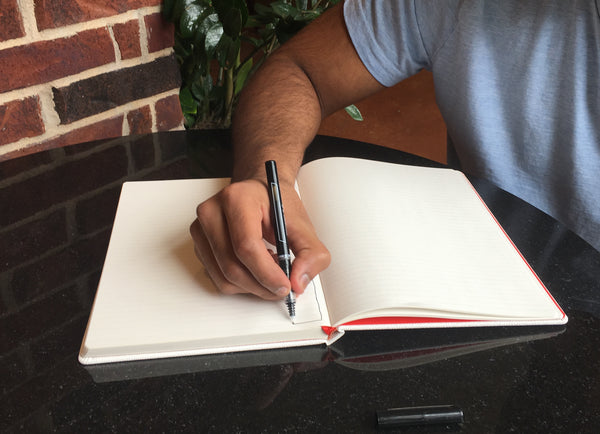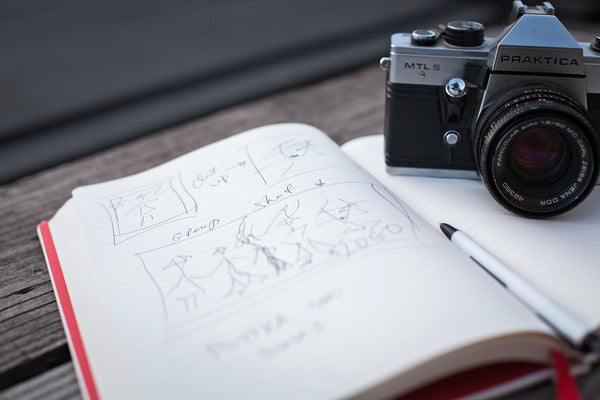5 Reasons Devs & Designers Should Bring a Notebook to Work


A computer geek is the last person you might expect to write in a notebook—because they live on the computer, right? But let’s not forget that Code&Quill was founded by a (former) code monkey—and precisely because he wanted a good writing tool away from his digital space.
We sell paper to the paperless generation, and we’re proud of it. Because as it turns out, even the most forward-thinking and tech-savvy among us sometimes need to go “backwards” to pen and paper.
This week, we’re explaining why that is, and how even developers and designers—people who work with technology for a living—can do better, smarter work by turning away from their keyboards and writing in their notebooks.
I personally like working things out such as pseudo-code, sitemaps, and low-fidelity wireframes via pen and paper because it's got the whole instant-gratification thing going on. I mean, pen and paper is just so much more accessible, takes less time, and is far more intimate than if I were to do the same tasks digitally.
— Ammo from Baltimore
1. Writing by hand helps you brainstorm and create new ideas.
There’s an exciting moment we all know. A new idea! The project starts forming in your mind. You’re just beginning to think about how something could work—a new app, a new website, a genius fix to an old problem. But quick! You’ve got to get it down! What do you use?
Computers, for all their power, are not made for brainstorming. Computers still aren't super-intuitive; at their core, they're fancy calculators. They make problem-solving easier, but they don’t necessarily make thinking easier. In our experience: the bigger and more abstract the problem, the quicker we'll give up on a computer and default back to pen and paper.

It’s this kind of “thinking space” that we’ve designed Code&Quill’s notebooks for. Tons of people have commented that the dual layout—grid on left, indentation rule on right—helps them see ideas more clearly. This seems doubly true for devs and designers, who often need to wireframe/diagram and take more detailed notes.
I use my [Code&Quill] to sketch out parts of an app I'm working on. The grid part I use to sketch out pages, and then I use the lined part to write down details. All that culminates in something neat and easy to reference when I need it.
— Kristina from Washington, D.C.
The two sides are different—lets me have two distinct halves to every page. There's something great about that. Keeps me creating in different ways.
— Andrew from North Dakota
Other users (esp. writers, students, and others working with "textual problems") specifically like the indentation rule’s hash marks (which is why we made another version with only that page style throughout).
2. Writing helps you solve problems with greater clarity, speed, and detail.
Especially if you’re a developer, you may find problem-solving is a lot of your job. Not only does your work have to work (i.e. function), but all of it usually has to, you know, solve a problem—or else, why were you working on it in the first place?

Writing notes, rather than typing them, allows you to take down all of the most important points, both quickly and in a manner that's intuitive to you. It helps keeps the information both concise and precise. Most importantly, writing allows you to think about technical problems without being stuck in technical minutiae.
Being a software engineer I am tasked with daily problems I need to solve myself, and being able to process my thoughts in this way has allowed me to solve the toughest of "head-scratchers."
— Samuel from Minnesota
I come up with the best algorithms and bug fixes when I'm away from the computer screen and undistracted by the code itself and just think about the problem "out loud" on paper.
— Kelly from Kentucky
3. Writing works better for in-the-moment collaboration.
Tech people gather around another low-tech device all the time—and that’s a whiteboard. Why? Because a whiteboard—not Google Docs, not a chatroom, not a Slack channel—is the best way for people to think through certain ideas together.
[My Code&Quill] is a space where I can write, sketch and get my ideas in order. It’s more personal. (It’s even bumped my Moleskine love down a notch.) I can take it out and jot down a quick note or thought and throw it back in my bag—something that's not easily done with my computer.
— Natalie M.
When you’re mobile, a big whiteboard isn’t always available—but a notebook can be. Sit down at a table, open it up, and put your heads together. The whole point of collaboration is doing better than a single person could do—and the most insightful collaboration happens when people talk it out and write it out together, not when they look at the same file remotely.

Not to mention, of course, that what's written in a notebook's pages stays there. No copying needed—all your notes stay in the same place. Because even when you use a whiteboard, the important bits need copying to... you get the point.
4. A notebook looks more professional to clients and co-workers.
Even if you keep your files pristine, a laptop will never look as classy as a leatherette or hardcover book. Some things—let’s be honest—are matters of appearance, and there’s something more impressive about a person who bothers to actually write things down in a book.

Think about a meeting with clients. Which is better for meeting them: your laptop or your notebook? Think about the complications of using your laptop. Never mind the clunkiness; by showing them your computer, you’re breaking the wall between your clients and where you do their work. A notebook adds a buffer layer between you and your clients—you can take down all the info they want and even produce some basic sketches and drawings on the spot, BUT they never get to see into your personal machine. It’s a win-win.
It's great to be able to take notes, then sketch out ideas with my clients.
— Miles from North Carolina
Not to mention: depending on how you set up your notebook, it can also house your personal planner/calendar, your to-do lists, and your diary or journal. If you work it, it works for you!
My C&Q is used for everything from holding my daily to-do lists to hobby sketches and cartooning, all the way over to meetings with clients for new design projects where I'll take notes and sketch out simple UI layouts. It's everything for me!
— Rafael from New York
5. Writing by hand gives your eyes and brain a break and lets you exercise different creative muscles.
As we’ve written before, eye strain isn’t really a thing (to most people). But anyone gets tired of staring at something all day—especially if it’s something you can’t figure out. Whenever you need to look away from the screen, some old-fashioned paper will give you a reprieve from the pixels.

If you stare too long at your computer screen, you may as well be head-butting the keyboard. But if you switch gears, take a break, and focus your attention on paper instead of a screen, you might find a completely fresh angle. It certainly wouldn't be the first time.
If you want to find the notebook that works best for your dev and design needs, take a look at our collection. If you want to see what our peeps are doing and hear the latest, come look at our photos on Instagram and our news on Facebook.





I just stumbled across your post, and I love how much effort you put it.
I hope it’s not too forward, but we just published There’s a book for that.
We developed custom notebooks for a variety of users and needs, lovingly thought through and carefully designed.
Please head over to https://www.abookforthat.com and have a look, we’d love to hear from you and include your thoughts in our work.
You will love it.
Best Regards, Oliver
Leave a comment